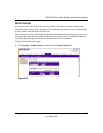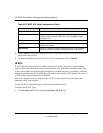
GS700TR Smart Switch Software Administration Manual
6-40 Managing Device Security
v1.0, May, 2008
You first create an IPv4-based or MAC-based rule and assign a unique ACL ID. Then, you define
the rules, which can identify protocols, source and destination IP and MAC addresses, and other
packet-matching criteria. Finally, you use the ID number to assign the ACL to a port or to a VLAN
interface.
The Security > ACL folder contains links to the following features:
• Basic:
• “MAC ACL” on page 6-40
• “MAC Rules” on page 6-42
• “MAC Binding Configuration” on page 6-44
• “MAC Binding Table” on page 6-45
• Advanced:
• “IP ACL” on page 6-46
• “IP Rules” on page 6-48
• “IP Extended Rule” on page 6-49
• “IP Binding Configuration” on page 6-53
• “IP Binding Table” on page 6-55
• “VLAN ACL Configuration” on page 6-56
• “ACL Interface/VLAN Summary” on page 6-57
MAC ACL
A MAC ACL consists of a set of rules which are matched sequentially against a packet. When a
packet meets the match criteria of a rule, the specified rule action (Permit/Deny) is taken and the
additional rules are not checked for a match.
There are multiple steps involved in defining an ACL and applying it to the switch. First, you use
the
“MAC ACL” page to define the ACL type and assign an ID to it. Then, you use the “MAC
Rules” page to create rules for the ACL. Finally, you use the “MAC Binding Configuration” page
to assign the ACL by its ID number to a port. You can use the “MAC Binding Table” page to view
the configurations.


















